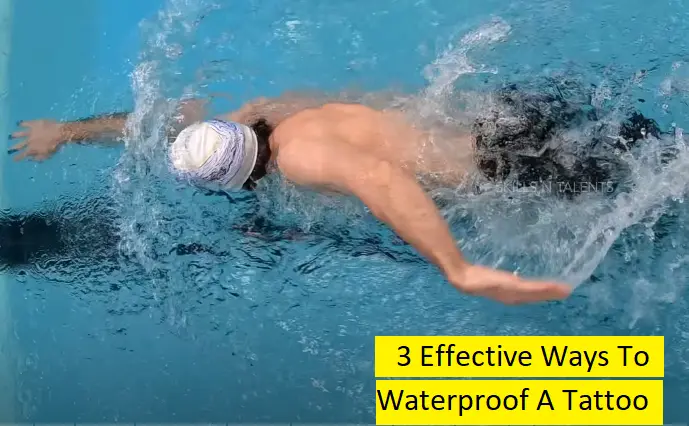How To Waterproof A Tattoo For Swimming
If you got a tattoo, you might be unsure whether it’s okay to go swimming. Swimming is a fantastic way to take advantage of the warm weather, and the swimming pool or beach is an excellent place to show off your new tattoo. An essential part of post-tattoo care is waterproofing your tattoo so that you can swim with it. Using these easy tips and methods, you can enjoy swimming without being concerned that your fresh tattoo will get damaged.
How To Waterproof A Tattoo For Swimming? You should know if you plan to swim with a new tattoo and ensure it is entirely encased with Vaseline, a waterproof bandage, or both. Once you have left the pool, quickly remove the cover and thoroughly wash the tattoo with water. You will also get some aftercare lotion from the tattooist to apply to the tattooed skin. After swimming, wash your tattoo off and use this lotion on the body art. If you want to know how long after the tattoo you can bath, check out our updated article about it.
How to Waterproof a Tattoo For Swimming
As stated before, salty water and chemicals are horrible for new tattoos. They cause the color of the artwork to fade continually and may cause discomfort or infections. As a consequence, you should hide both existing and fresh ink tattoos. By doing this, you may prolong their life and maintain the richness and brilliance of their shades.

1. Wrap your tattoo with a waterproof bandage
A design cannot be waterproofed entirely before it completely heals. However, if swimming is necessary, the best alternative is to protect your ink with a waterproofing dressing like Sanaderm, Tegaderm, or clinical retention tapes. Apply the bandage as soon as possible before swimming to prevent maximum sweat absorption as possible.
Avoid swimming in oceans, rivers, and lakes at all costs. Although swimming pool chlorine is still dangerous for ink, the organisms present in sizable freshwater bodies, mainly coastal freshwater bodies, are much more toxic and unexpected. Waterproof bandages are the most valuable and effective method of safeguarding your skin while swimming. They are often used by and recommended by tattoo artists to their clients.
2. Cover your tattoo with petroleum jelly or Vaseline
The best way to shield your tattoo from wetness is Vaseline. This material has wax and paraffin in its manufacture. In water, they don’t dissolve. Vaseline can guard the skin’s surface against moisture even if applied thinly.
Vaseline traps moisture, so putting a little layer over your waterproof bandage gives an additional barrier of defense against outside elements for your ink. Coconut oil, cocoa butter, and other water-based lotions can provide the same safety if petroleum jelly irritates your skin. You may also ask your tattoo artist for recommendations.
3. Liquid Sealant
A liquid sealer is another suitable method for keeping a design safe. It can also be applied to fresh ink tattoos to speed up healing. It is anti-allergic and has antibacterial capabilities. However, liquid sealants have several unique uses: They must be used on blood-free skin.
Spraying liquid sealant at a distance of 11 to 17 inches is recommended. Otherwise, a burning feeling could happen because the amount of the substance is excessive. Additionally, it will only take 2-3 sprays to cover entirely and dry in another 2-3 minutes. You will have no trouble swimming, bathing, or playing games for three hours.
How Long to Wait Before Swimming
The healing process of a tattoo takes time. It can be split down into the following stages and typically takes three to five weeks:
- First Day: The skin is warm and a little reddish. It might leak liquids. Also, pain is possible.
- First Week: Due to the process of recovery, ink colors fade. The artwork can also start peeling off, but you shouldn’t remove it.
- Second Week: There is an apparent decrease in redness, but intense itching starts. To prevent cracks and sores, the skin must be moisturized.
- Third Week: The redness and skin scabs on the design should be gone. If not, it might be an infection, in which case you require medical care.
- After the First Month, You succeeded! Now that your tattoo has healed, you can swim in the pool, lakes, and the ocean without any danger.
Tattoo Care Tips for Swimming
The initial few days are vital to care for a tattoo. Fresh ink is an exposed wound, as was already said, so care must be taken. Use the follow-up cream that the tattooist gave you at all times. They will guide you on how frequently you should use it, but typically, 2 to 3 times per day.
The body part tattooed initially needs to be kept healthy and hydrated while it recovers. This cream will achieve precisely that, and once applied, you shouldn’t cover it; instead, let it air dry naturally. Your tattoo will scab and flake off as it heals. Although it might itch, you should never scratch the area because doing so could harm the ink. The scabs that grow over the tattoo should never be picked up and kept dry.
Keep your new tattoo out of the sun for several days to avoid interfering with its recovery. Additionally, since sunscreen includes chemicals that can lead to an infection, you shouldn’t apply it while it’s recovering. Cover it up with some soft garments. You can use sunscreen once it has recovered the same way you would on the rest of your body.
Ensure that your tattoo is in the water for the shortest period possible. Infections and tattoo damage are more likely to occur when you swim or use your waterproof bandage for an extended time. As soon as you exit the water, remove your waterproof seal to reduce the spread of bacteria. Your body and pieces are at greater risk of damage the longer you wait.
FAQs
conclusion
In conclusion, swimming of any type should be avoided during tattooing till the tattoo has recovered. You risk getting sick or harming your new tattoo if you don’t follow care recommendations. If swimming is your only option, you can still protect your tattoo using the abovementioned methods, a waterproof bandage, and Vaseline.
In this article, we write about how to waterproof a tattoo for swimming. We hope you get the idea of swimming with a tattoo. You can contact us without hesitation if you still need help with your tattoo. Thanks for reading!

